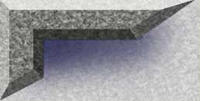Sinking Sandsucker Desmond
By James Donahue
Sandsuckers on the Great Lakes still exist,
although because of tough new pollution laws, they are all owned and operated by the U. S. Army Corps of Engineers.
That is because sandsuckers
are exactly what the name says they are. They are giant floating vacuum sweepers that suck silt from the bottom of harbors,
rivers and other waterways keeping seaways open for the big ships and pleasure craft.
During earlier times,
before industrial waste contaminated lake bottoms, private companies made a business of extracting lake-bottom sand and selling
it.
That was the business
of the wooden hulled propeller Desmond during its final years on the lakes. Owned by the Cream City Sand Company of Milwaukee, the Desmond had an active life, generally working from harbor-to-harbor along the Lake Michigan coast.
The boat was completing
one of its last planned trips of the season when it sprang a leak and sank in a winter gale off South Chicago Lighthouse on
Sept. 8, 1917. Seven members of the crew perished, but six others were saved when Chicago
harbor tugs pulled them from the water.
The Desmond, under the
command of Capt. Emil Thorsen, left St. Joseph in southwestern Lower Michigan in the afternoon,
bound for Racine, Wisconsin,
with a load of sand. The boat was blown off course, however, when caught in a storm that brought high northerly winds and
sub-zero degree temperatures.
The storm was so bad
Thorsen decided to steer for Chicago harbor instead of continuing
a course against the wind and seas.
Survivor Herman Lederhaus
said crew members feared for their lives and pleaded with Thorsen to run the ship on the beach. Thorsen refused. “In
thirty years on the lakes, I never have lost a ship. If the Desmond goes down, I will go with her,” he said.
Thorsen kept his word.
He died with the ship that day. The tragedy is that he almost made it.
The rolling seas shifted
the sand in the Desmond’s hold, causing a dangerous starboard list. Crew members shoveled desperately, attempting to
get the vessel back on an even keel.
The lights of Chicago harbor were in sight when the ship developed a serious leak
in the stern. That was at about 2 a.m. Chief Engineer Jack Stahl was forced to shut down the engines and use all of his available
steam pressure to run the ship’s pumps. Still the water gained.
The crew worked desperately
for the rest of the night, trying to keep their ship afloat and hoping that someone on shore would notice their plight and
send help. The water continued to rise until one of the coal bunkers collapsed. Floating pieces of coal clogged the pumps
and siphons.
By now the ship’s
list was worse and it looked as if only a miracle would save it.
Thorsen made one final
attempt to save his command. He and four others launched a lifeboat. They apparently planned to row into the harbor and summon
a tug. But as the small boat pulled away, the ship suddenly lurched and rolled on its side. The stack hit and capsized the
lifeboat, spilling all five sailors in the lake.
Lederhaus said he and
seven other men still on the Desmond scrambled over the side as the ship rolled. He said the boat floated on its side for
a while and the men attempted to ride out the storm clinging to it.
“I threw a rope
to the five who were struggling in the water. Two of them, the captain and (Frank) Kipper, seized it. We pulled them to the
side of the ship. Captain Thorsen froze to death as he lay there.
“We shouted and
screamed and waved our coats until we became too numb to move. Finally, we attracted the attention of men on board a steamer,”
Lederhaus said.
That steamer was the
tug William A. Field, under the command of Capt. William Bowen.
No sooner had the Field
spotted the overturned Desmond, when two other tugs, the Gary and North Harbor, also were seen steaming to the
scene.
Lederhaus, first mate
Arthur M. Emkey, second engineer T. J. Cunningham, Kipper, Carl Olson and Gus Yonson were rescued alive before the Desmond
sank.
More Ship Stories
Return to The Mind of James Donahue

